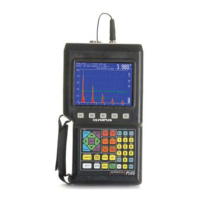Using Software Options
Part # 910-250C
117
Figure 68 Thin Weld Tolerance Level
To adjust the minimum acceptable echo spacing, use the LEFT and RIGHT slewing/
arrow keys to compress or expand the vertical echo placement marks on the purple
tolerance level line. The default minimum acceptable echo spacing is set to allow for
nuggets that are between 85% and 100% as thick as the GOOD weld condition.
Compressing the echo spacing tolerance allows for greater acceptable nugget indentation,
while expanding the echo spacing requires indentation to adhere more strictly to the
reference GOOD condition.
Once the desired adjustment is made (if any), press [ENTER] to complete the Advanced
Algorithm Training process. To enter inspection mode, press the [F5] key, INSPECT.
The Spotweld Assistant software dynamically rates unknown weld conditions using the
parameters adjusted during the advanced algorithm training process. Weld templates can
be saved using the Weld Overlay feature described in the INSPECTION MODE (BASIC)
section.
9.8.7 Spotweld Assistant and the EPOCH 4PLUS Datalogger
The EPOCH 4PLUS Spotweld Assistant software option makes powerful use of the
onboard alphanumeric datalogger to easily store, recall, and save Spotweld transducer
setups, customized algorithm adjustments, and entire inspection plans. The onboard
datalogger functionality is further enhanced by advanced features in the EPOCH 4PLUS
interface program, GageView Pro.
9.8.7.1 Calibration Files
Once the GOOD and UNWELD references have been stored and any advanced algorithm
training is completed, the EPOCH 4PLUS Spotweld Assistant allows the operator to store
the entire calibration setting for quick recall of all parameters at a later time. This is
especially helpful for inspections that require the interrogation of multiple nugget sizes,
and therefore the use of multiple transducers.

